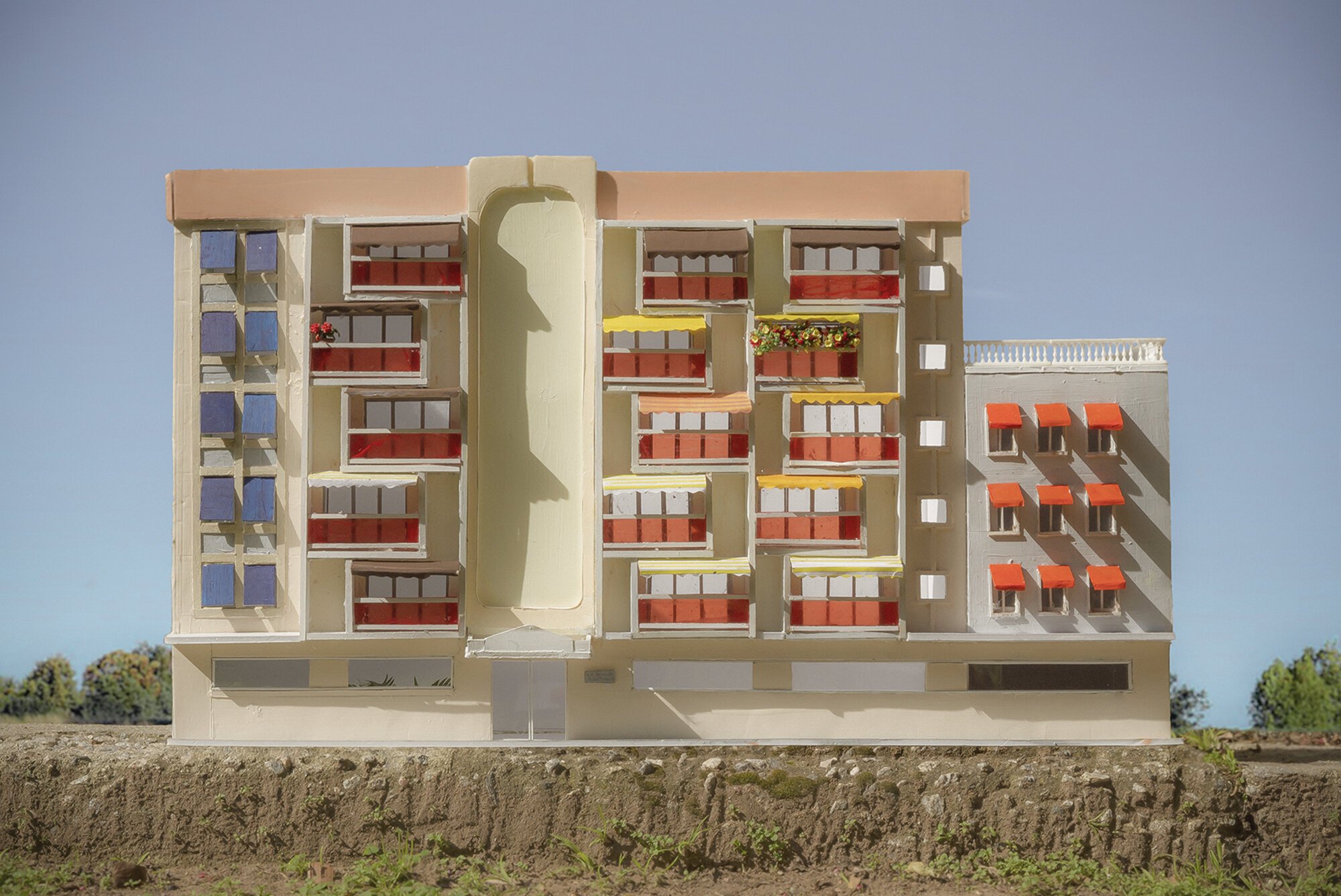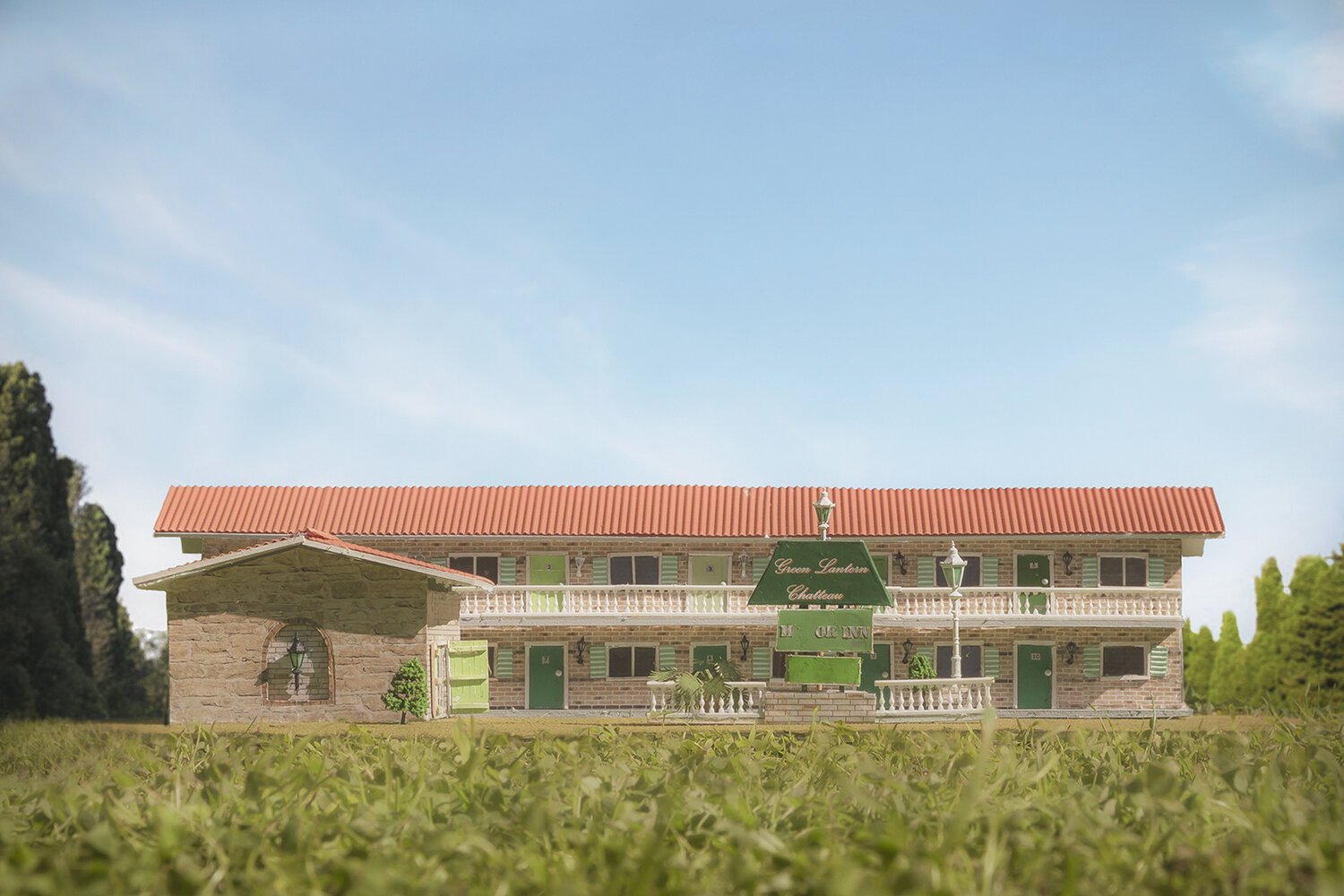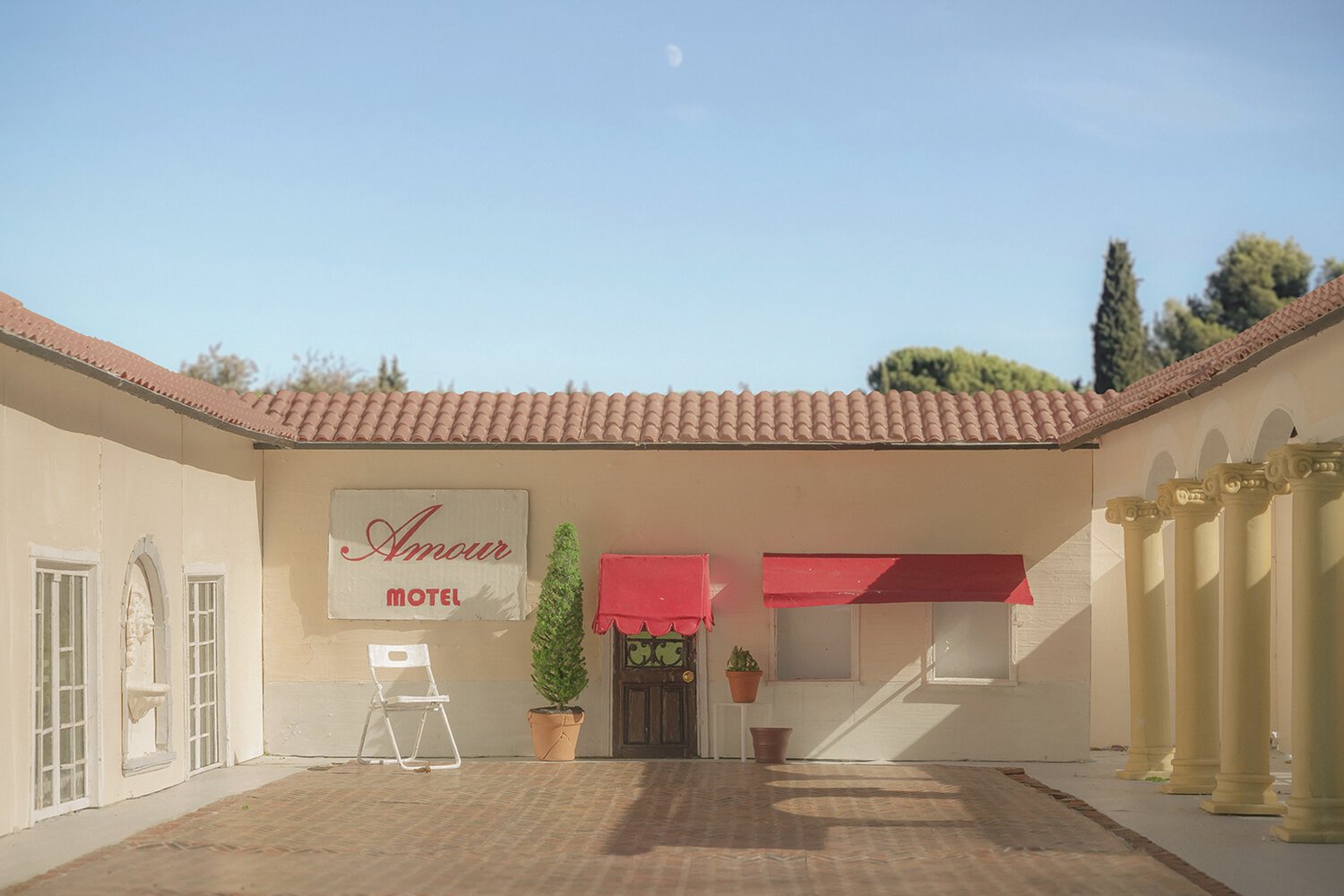Anna Carey: Faraway
June 20th, 2020
Working at the intersection between photography, model-making, film and drawing, Anna Carey’s series Faraway invites the viewer to consider memory, perspective and the lived experience, through photographs of intricate architectural models. Public Offerings Ltd. caught up with Anna to talk process, colour and creating art from a sense of déjà vu.
POL: Your images are constructions, created through your multi-disciplined approach to image making. Can you give us a brief introduction to how your work is made?
AC: I construct miniature architectural models based on vernacular architecture which I photograph and display as large prints. The photograph magnifies the model and reveals to the viewer that the photograph has been constructed. This miniature creates a disorientating and imaginative experience for the viewer to see from a new perspective and reflect on reality and memory.
POL: Both fictive and yet also based in memory, how do you find the locations you create through your model making?
AC: Each body of work is slightly different most of the works are based on photographs as well as real encounters of spaces. For instance, works from the series Stardust were based on images I sourced through google maps in which I made my own maps and pinned Stardust motels across the world. My recent series Faraway were based memories and imaginations of triggered while walking the streets of Paris and Provence and observing the urban environment. All the works are based on a space the trigger a memory. The work is like this fragmented moment in my mind in which I mix reality memory and imagination.
POL: You mention the works in your series Faraway are inspired by places seen during your visit to the south of France, how did you find your experience of creating these differed from works inspired by America or your native Australia?
AC: Since the place was not as familiar to me I took a lot of time observing urban trends and finding familiar spaces that triggered memory. The series is very eclectic as this familiar felling like déjà vu was the base of each work. The work also actually felt very adventurous as I embraced different colour combinations and architectural features such as lanterns, french windows and statues. I mixed these older international styles with familiar architecture just like people mix styles in our globalised culture. I also aimed to create a dreamy sense of fantasy and escape within the architecture to express the blurred faraway feeling we have when transiting between spaces and places in the world.
POL: There seems to be a lot of juxtaposing dichotomies at play in your work - escapism in the familiar, the magic in the mundane - you seem to take the everyday and make it something to mediate on. Why do you feel you’re so drawn to the normal, over the fairytale landscapes of castles and chateaus you could have focused on?
AC: Thank-you! Since I am so interested in involuntary memory exploring architecture of the everyday in a foreign city felt like a natural progression and good entry point. Place is also a focus in my work and when traveling I tend to compare the familiar with the foreign. Identifying indifference and difference allows us to understand how this place is different to that place and helps us identify our own place in the world. This type of similar generic architecture I depict reveals the small differences and idiosyncrasies. It also is very much part of the lived experience of a place in contrast to castles which these days is more of a tourist experience.
“This miniature creates a disorientating and imaginative experience for the viewer to see from a new perspective and reflect on reality and memory.”
POL: Almost as though creating a dolls house for adults, you’ve spoken about your work creating architectural spaces as a place for imagination. What is it about buildings and locations that you feel makes them such good conduits for memories?
AC: The architecture I work with is a deeply familiar homogenous global style the has been produced throughout the world and therefore holds many different memories for many people. Even if you haven’t lived in a place like this or traveled through one the chances are you drive past a place like this daily or experience it through film and television. When dealing with memory we always rely on imagination to fill in the blanks. My models are not the exact way these places are in reality, it’s how I remember them.
POL: It’s clear that colour plays a big part in your locations and the sense of memory they produce, how have you formed this colour language in your work?
AC: Colour has the ability to evoke a sensory rush for viewer and bring back memories and feelings. Therefore, I like to explore the connection between space colour, memory and place. I really investigate this in the series In Search of Rainbows where I based each space on a dominant colour in which imagined and combined elements that I thought associate with the colour.
For instance, Yellow is the brightest colour of the rainbow spectrum and closest to white light, which can be seen as celestial light; a symbol of clarity, consciousness, enlightenment and the divine in cultures. The space consists of a triangular window with an eye surrounded by rays of light similar to the eye symbol to represent a higher cosmic force like sun and moon; therefore I titled the work Yellow Moon. The work is placed and photographed around the Palm Springs and Joshua Tree desert, a place where people go for expansion.
The work Green Paradise is very different, I reimagined a green space with an exotic mural, palm tree pot plants, art deco and situated it in a leafy green area. For all of these Rainbow works I reference images via Google maps where I located and created geo-tagged colour maps which reveals where dominant colours of architecture are in the world. Since this research I have a basic understanding of colour and place and now use colour combinations in my work to express a certain place.
POL: What’s next on the horizon for you? Where are you going to take us next through your imagery?
AC: I have so many ideas but making models is a slow and steady process. Believe it or not I actually do want to explore castles, however I don’t want to depict them like a fairy tale castle instead I want to mix elements from ancient castles with the contemporary quotidian similar to the way home owners mix multiple styles to create “suburban castles”.
About Anna Carey
Anna Carey is an Australian artist whose work overlaps photography, model-making, film and drawing. Through memory and imagination, she creates fictive architectural spaces based on familiar iconic architecture which she photographs. The camera lens magnifies the model with all its imperfections and reminds the viewer that the photograph has been constructed with a miniature materialized object. This aims to reawaken imaginations for the viewer by creating a space of stillness and reflection for one to drift between reality and daydreams – for rediscovering the universe that is inside ourselves.
Anna completed a Bachelor of Visual Media with Honours (first class) at Queensland College of Art and is currently undertaking postgraduate studies with QCA. She has exhibited at Photo la, Los Angeles; Artereal Gallery, Sydney; Andrew Baker Art Dealer, Brisbane; Dlux Media Arts, Federation Square Melbourne and the Museum of Brisbane. She has been shortlisted in numerous prizes including The Churchie National Emerging Art Award, the Queensland Regional Art Awardsand he Josephine Ulrick and Win Schubert Photography Award which she received the acquisition award. Her work has been acquired by The Los Angeles County Museum of Art, National Gallery of Australia, Artbank, Gold Coast City Art Gallery, University of Queensland, Caboolture Regional Art Gallery and numerous private collections.







